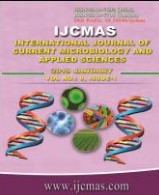


 National Academy of Agricultural Sciences (NAAS)
National Academy of Agricultural Sciences (NAAS)

|
PRINT ISSN : 2319-7692
Online ISSN : 2319-7706 Issues : 12 per year Publisher : Excellent Publishers Email : editorijcmas@gmail.com / submit@ijcmas.com Editor-in-chief: Dr.M.Prakash Index Copernicus ICV 2018: 95.39 NAAS RATING 2020: 5.38 |
A field experiment was conducted at Main Agriculture Research Station, University of Agriculture Sciences, Dharwad, to study the disease development in relation to weather parameters, which clearly depicts the relationship between the weather factors like temperature, relative humidity, rainfall and number of rainy days with the development of the maydis leaf blight of maize. Observations were taken from 31st standard week to 39th standard weeks at weekly interval. The PDI was lowest during 31st standard week (8.34 %) and increased throughout the cropping period. It was peak during last stage that is 39th standard week (80.07 %). During cropping period maximum temperature ranged from 250C (31st standard week) to 29.40C (35th standard week), minimum temperature from 19.30C (35th standard week) to 210C (37th standard week), relative humidity (morning) from 91 per cent (35th standard week) to 95 per cent (38th standard week) and relative humidity (evening) from 63 per cent (35th standard week) to 85 per cent (31st standard week). Cumulative weekly rainfall ranged from 59.60 mm (31st standard week) to 237.80 mm (39th standard week). No of rainy days ranged from 1 (32nd standard week) to 6 (37th standard week). With respect to weather studies the per cent disease index at weekly intervals were calculated. This was progressing at linear rate as the age of the plant was increasing. Maximum temperature (r = 0.40), minimum temperature (r = 0.03) were not significantly positively correlated with PDI. Morning relative humidity (r = -0.03), evening relative humidity (r = -0.45) and number of rainy days (r = -0.12) were not significantly negatively correlated with PDI. While, the rainfall showed a highly significant positive correlation with PDI.
 |
 |
 |
 |
 |